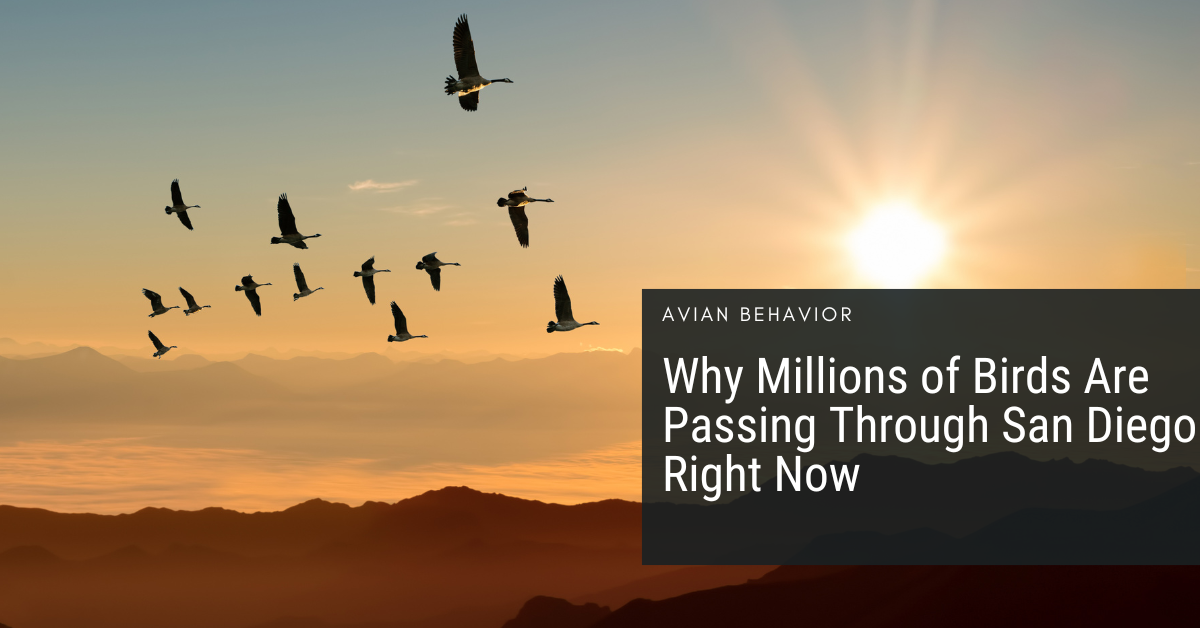
29 Oct Why Millions of Birds Are Passing Through San Diego Right Now
This month we celebrated World Migratory Bird Day, a reminder that twice a year, billions of birds undertake one of nature’s most incredible journeys. Some fly thousands of miles between breeding and wintering grounds, navigating by stars, magnetic fields, and landmarks we’re only beginning to understand.
But here’s what most people don’t realize: your backyard in San Diego plays a critical role in whether those journeys succeed or fail.
Why Birds Migrate (And Why It’s So Costly)
Migration isn’t a choice — it’s survival. Birds migrate to follow food sources, escape harsh weather, and find suitable breeding habitat. When insects disappear in northern winters or nesting sites become scarce, migration becomes the only option.
But the journey is brutal. Migratory birds burn through enormous amounts of energy, sometimes losing up to 50% of their body weight during a single flight. They face predators, storms, exhaustion, and increasingly, human-made obstacles like buildings, power lines, and habitat loss.
Smaller birds like warblers might fly 1,500 miles nonstop across the Gulf of Mexico. Shorebirds travel from the Arctic to South America. Bar-tailed godwits fly 7,000 miles without stopping. These aren’t leisurely trips — they’re endurance tests that push birds to their physiological limits.
And many don’t make it.
Why San Diego Matters for Migratory Birds
San Diego County sits along the Pacific Flyway, one of the major migration routes in North America. That means millions of birds pass through our region twice a year — spring and fall — using our coastal areas, canyons, and urban green spaces as critical rest stops.
Think of it like a gas station on a cross-country road trip. Birds need safe places to land, food to refuel, and water to rehydrate before continuing their journey. Without these stopover sites, migration becomes even more dangerous.
Your yard, your neighborhood park, even your apartment balcony can provide that lifesaving rest stop.
How You Can Help (Right Now, Right Here)
The good news? Helping migratory birds doesn’t require expensive equipment or a biology degree. Small actions in your own space make a real difference.
1. Turn Off Unnecessary Lights at Night (Especially During Migration Season)
Artificial light disorients migrating birds, especially during spring (March-May) and fall (August-November) migration. Birds navigate by starlight, and bright city lights can confuse them, causing collisions with buildings or exhausting them as they circle endlessly.
What you can do:
- Turn off outdoor lights when not needed, especially between midnight and dawn
- Close blinds at night to reduce light spill
- Use motion sensors instead of all-night lighting
- Advocate for “lights out” programs in your community
2. Make Your Windows Safer
Window collisions kill an estimated 1 billion birds annually in the U.S. Birds see reflections of sky and trees in glass and fly directly into it.
What you can do:
- Apply bird-safe window decals, tape, or screens (spaced no more than 2 inches apart)
- Move bird feeders either within 3 feet of windows (so birds can’t build up speed) or more than 30 feet away
- Close curtains or blinds during peak migration
- Consider exterior screens or netting for problem windows
3. Keep Cats Indoors
Outdoor and feral cats kill billions of birds each year in the United States. Migratory birds, already exhausted from their journey, are especially vulnerable.
What you can do:
- Keep your cats inside, especially during migration season
- If your cat goes outside, use a bell collar and limit outdoor time to midday when birds are less active
- Support Trap-Neuter-Return (TNR) programs for feral cat populations
4. Plant Native Plants That Provide Food
Migratory birds need high-energy food sources like insects, berries, and nectar. Native plants support the insects and fruits that fuel migration.
What you can do:
- Plant California natives like toyon, manzanita, California fuchsia, and sages
- Avoid pesticides, which eliminate the insects birds need
- Leave seed heads on flowers in fall for migrating sparrows and finches
- Provide water sources — even a shallow dish refilled daily helps
5. Reduce Pesticide Use
Insects are the primary food source for most migratory songbirds. When we eliminate insects with pesticides, we eliminate the fuel birds need to survive migration.
What you can do:
- Skip the pesticides and let beneficial insects do the work
- Accept a little leaf damage — it means your yard is supporting life
- Choose organic options when pest control is absolutely necessary
6. Advocate for Bird-Friendly Policies
Individual action matters, but systemic change amplifies impact.
What you can do:
- Support local “lights out” initiatives during migration
- Advocate for bird-safe building design in new construction
- Support habitat preservation and restoration projects
- Educate others about simple steps they can take
The Bigger Picture
At Avian Behavior Conservancy, our ambassador birds don’t migrate. But they help us fund conservation efforts for species that do — from supporting field research to raising awareness about the challenges migratory birds face.
When you visit us and meet our birds, you’re supporting that work. And when you take action in your own backyard, you’re directly helping the wild birds that need it most.
Migration is one of nature’s most impressive feats. But it only works if birds have safe places to rest, refuel, and recover along the way.
Your backyard can be one of those places.
Want to learn more about birds and conservation? Join us for one of our experiences and meet the ambassador birds working to protect their wild relatives.

